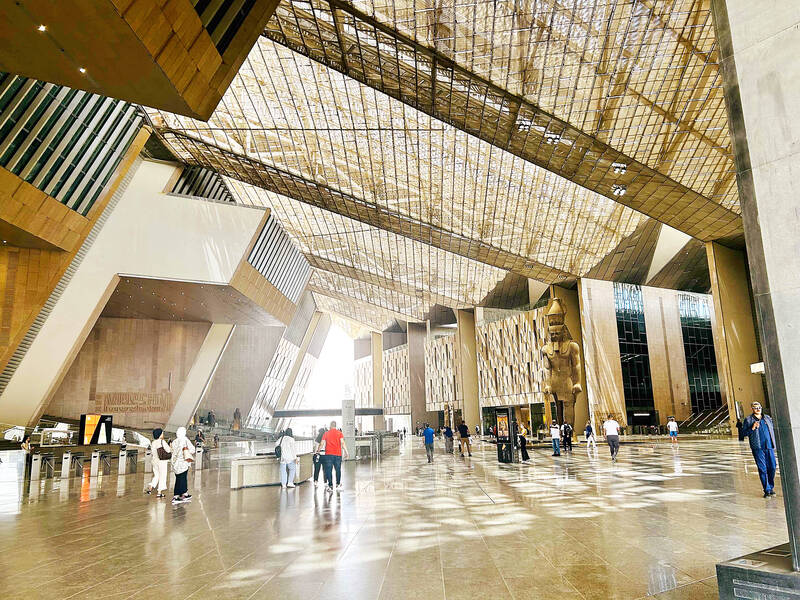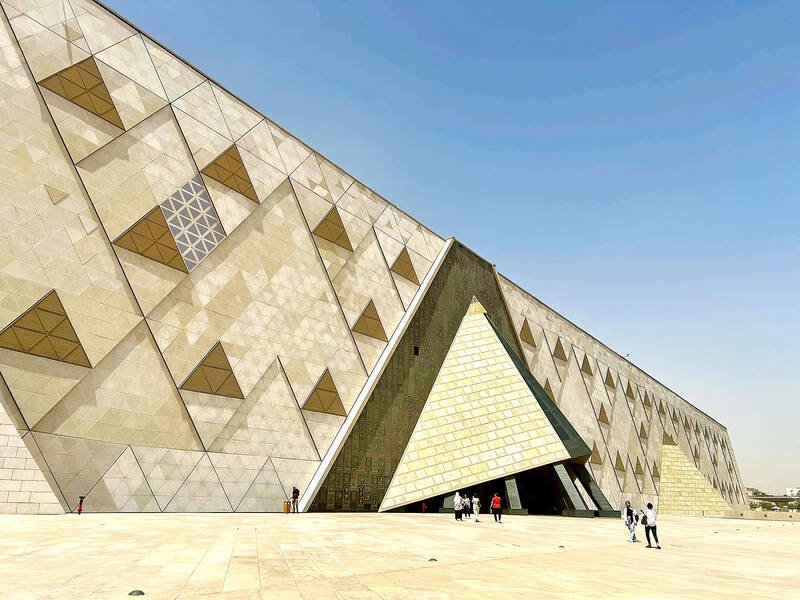After years of delay, the Grand Egyptian Museum in Cairo was unveiled in a limited soft opening on Wednesday last week, finally giving people a peek at the design concept of Taiwanese-American architect Peng Shih-fu (彭士佛) and his wife, Roisin Heneghan.
Initially scheduled to be completed by 2013, what is expected to be the world’s largest archeology museum faced countless delays, primarily due to environmental, financial and political hurdles.
The design that allows visitors to experience ancient Egyptian values was conceived more than 20 years ago.

Photo: CNA
The design was finalized in 2003, when plans from Irish firm Heneghan Peng Architects was chosen out of 1,557 submissions from 82 nations in what was documented as the second-largest architectural competition in modern history.
The Irish company was founded by Peng, a Taiwanese immigrant to the US, and his wife, Heneghan, from Ireland.
Based on the architecture firm’s design, the museum sits squarely between the Giza Plateau and the Nile Valley Plain in what Peng said was an intentional choice he made in reflection of ancient Egypt’s concept of life and death.

Photo: CNA
According to the architect, only his firm among the 1,557 entrants in the competition, which was launched in January 2002, proposed to build the museum between the plateau and the plain to embrace the beauty of life and death, as well as the unique geography of the locations.
The other competitors recommended that it be erected either on the plateau or on the plain, he said.
“Architecture needs to respect the environment,” Peng said in an interview. “The design concept is presented in two parts through the main construction of the architecture and its surrounding landscape. The main body of the museum reflects the past, while the outdoor scenic area presents the rich lives of modern-day humans.”
“The entire compound blends together the interior and exterior; the past and the present; death and life,” he added.
While designing the museum, he did a lot of research on ancient Egypt, its culture, and the relationship between its heritage architectures and the civilization’s geography, Peng said.
“It is because of this geographical location that Egypt was able to embark on a 5,000-year journey through history,” he said.
Ancient Egyptians saw the sun rising in the east as a metaphor for birth and the sunset in the west as a symbol of death, which is why ancient temples were historically built on the eastern bank of the Nile, while the monuments for deceased pharaohs were traditionally erected on the western bank.
In honor of the cultural concept, Peng and his firm have visitors enter the museum from the proximity of the Nile Valley Plain and gradually move in a westward direction toward the Giza Plateau.
Moving from the fertile east to the royal tombs of the west, visitors will experience the crossroads that is life and death, Peng said, adding that a design that can showcase geographical uniqueness and local history is pivotal to a museum.
In the soft opening, up to 4,000 pre-registered visitors a day are given private tours of the museum’s commercial area, exterior gardens, Grand Hall, Grand Staircase and main galleries.
The flagship exhibit, the Tutankhamun Galleries, as well as its Children’s Museum and Khufu’s Boat Museum, remain closed to the public.
Once the museum officially opens, which could happen before the end of this year, more than 100,000 artifacts from ancient Egyptian dynasties are to be displayed over the museum’s 81,011m2 of floor space.
The most popular gallery is likely be the complete King Tut collection that consists of about 5,000 pieces, many of which are to be revealed to the world for the first time since the first items were unearthed in 1922.

An essay competition jointly organized by a local writing society and a publisher affiliated with the Chinese Communist Party (CCP) might have contravened the Act Governing Relations Between the People of the Taiwan Area and the Mainland Area (臺灣地區與大陸地區人民關係條例), the Mainland Affairs Council (MAC) said on Thursday. “In this case, the partner organization is clearly an agency under the CCP’s Fujian Provincial Committee,” MAC Deputy Minister and spokesperson Liang Wen-chieh (梁文傑) said at a news briefing in Taipei. “It also involves bringing Taiwanese students to China with all-expenses-paid arrangements to attend award ceremonies and camps,” Liang said. Those two “characteristics” are typically sufficient

A magnitude 5.9 earthquake that struck about 33km off the coast of Hualien City was the "main shock" in a series of quakes in the area, with aftershocks expected over the next three days, the Central Weather Administration (CWA) said yesterday. Prior to the magnitude 5.9 quake shaking most of Taiwan at 6:53pm yesterday, six other earthquakes stronger than a magnitude of 4, starting with a magnitude 5.5 quake at 6:09pm, occurred in the area. CWA Seismological Center Director Wu Chien-fu (吳健富) confirmed that the quakes were all part of the same series and that the magnitude 5.5 temblor was

The brilliant blue waters, thick foliage and bucolic atmosphere on this seemingly idyllic archipelago deep in the Pacific Ocean belie the key role it now plays in a titanic geopolitical struggle. Palau is again on the front line as China, and the US and its allies prepare their forces in an intensifying contest for control over the Asia-Pacific region. The democratic nation of just 17,000 people hosts US-controlled airstrips and soon-to-be-completed radar installations that the US military describes as “critical” to monitoring vast swathes of water and airspace. It is also a key piece of the second island chain, a string of

The Central Weather Administration has issued a heat alert for southeastern Taiwan, warning of temperatures as high as 36°C today, while alerting some coastal areas of strong winds later in the day. Kaohsiung’s Neimen District (內門) and Pingtung County’s Neipu Township (內埔) are under an orange heat alert, which warns of temperatures as high as 36°C for three consecutive days, the CWA said, citing southwest winds. The heat would also extend to Tainan’s Nansi (楠西) and Yujing (玉井) districts, as well as Pingtung’s Gaoshu (高樹), Yanpu (鹽埔) and Majia (瑪家) townships, it said, forecasting highs of up to 36°C in those areas